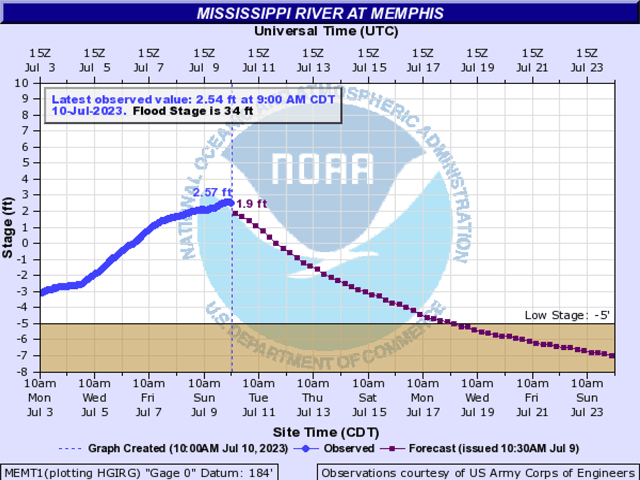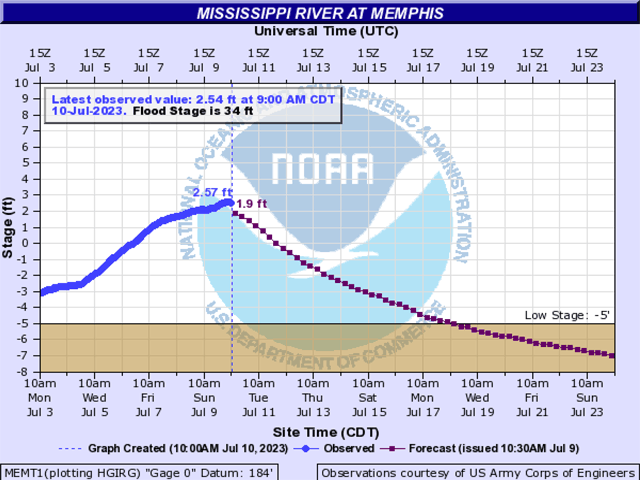Market Matters Blog
Low Water Levels Not Just a Concern on the US River System
It's not just the U.S. River system that has seen low water conditions this summer. The Rhine River in Germany saw levels drop due to dry weather, causing shippers to lighten their loads, similar to what is done on the Mississippi River, costing shippers to pay the same freight cost to move less product.
On the Rhine, conditions recently improved in the southern regions, but the northern area remains dry and shallow, especially around Cologne and Duisburg, according to various shipping news outlets. The current forecast for that area does not give much hope for relief.
While it's not unusual for our rivers to lose water during the summer months, especially when it is unseasonably hot, because evaporation occurs and rain is not helping rebuild the levels.
"Even in the midst of the high water conditions a couple months ago, my concern was that we could quickly return to low water levels on the Mississippi River given how much of the region's ground was dry and most reservoirs were still low," said Mike Steenhoek, executive director of the soy transportation coalition. "The worry was that any prolonged period of dry weather could result in the pendulum swinging back to low water conditions. This unfortunately has occurred. It serves as a reminder that drought not only inhibits the ability to grow a crop, but it also inhibits the ability to transport that crop."
The Mississippi River at Memphis, Tennessee, is an area sensitive to low water and slowdowns, and is the area where stoppages most commonly occur. Back in October of 2022, the Memphis gauge hit a historical low level of minus 10.8 feet. Currently, Memphis gauge is at plus 2.54 feet, but unless steady rains appear, it is forecast to drop below zero gauge by July 12 and fall further. The Mississippi River at St. Louis, Missouri, is also hovering near zero gauge again at plus 2.1 feet and is expected to fall in the next few weeks.
Draft restrictions remain in place and if levels drop, tow sizes will be reduced. In addition, dredging is taking place with the Dredge Jadwin working at mile 483-489, causing rolling 24-hour closures. Dredges work in the low water spots to keep a channel open for barges to move through safely.
On the flip side, above St. Louis in the Upper Mississippi, the heavy spring floods caused sand and silt to be carried throughout the river due to the stronger currents and faster movement of the water. This is known as "shoaling" and can cause dangerous conditions for barges moving up and down the river through the channels. The Dredge Potter has been scheduled to start dredging at UMR mile 171 and the Dredge Hurley is estimated to arrive at UMR mile 16 on July 11.
P[L1] D[0x0] M[300x250] OOP[F] ADUNIT[] T[]
Barge lines are also faced with lower freight values due to low water issues and, on top of that, demand for corn and soybeans at the Gulf for export is slow right now. What happens is that you will see barges parked along the river that have no home to go to and/or cheap freight values will cause barge lines to sit it out for now.
While expectations are that we shouldn't see the severe issues we saw last fall on the Mississippi River, it's something to keep an eye on for sure.
PANAMA CANAL ISSUES DUE TO DROUGHT
The Panama Canal is also experiencing challenges due to drought conditions, noted Steenhoek. "Since the Panama Canal is not a sea level canal and instead utilizes locks, the operation of the canal is a function of available precipitation that occurs to fill Gatun Lake -- the reservoir that feeds fresh water to the canal locks."
According to the Panama Canal Authority, over the past five years, average water levels at Gatun Lake during the month of July is 84.9 ft. The current depth is 79.7 ft. (https://pancanal.com/…)
"Every time the original 1914 'Panamax' locks allow a ship passage, 50 million gallons of water exit the lock chamber to eventually join with the Atlantic or Pacific oceans. Due to multi-year drought conditions, the Panama Canal Authority is having to resort to water saving measures," said Steenhoek.
The "Neopanamax" locks, opened in 2016, have a draft restriction of 44 feet compared to the normal 50 feet. Container vessels, LNG vessels and cruise ships largely utilize the Neopanamax locks. Dry bulk vessels, including soybeans and grain, continue to overwhelmingly utilize the original 1914 Panamax locks, added Steenhoek.
The Panama Canal Authority partnered with the U.S. Army Corp of Engineers (USACE) to find more water sources within its current watershed, noted Bloomberg. "The canal authority received an initial report from the USACE stating there are no solutions within the canal's watershed, meaning the canal authority will have to find new water sources outside its jurisdiction. Securing additional water supply will be key to the waterway's future, Ricaurte Vasquez, authority administrator, said in a June 28 interview."
"The Panama Canal Authority originally had announced a half-foot draft reduction for the Panamax locks from the normal 39.5 ft. to 39 ft., but recent rainfall allowed them to postpone that decision. The Panama Canal is a critical link in the supply chain for U.S. soybeans and grain, facilitating a significant volume of exports originating from the Gulf of Mexico to be shipped to customers in Asia," said Steenhoek.
NWS 48-hour precipitation forecast: https://www.weather.gov/…
Ohio River Valley daily forecast: https://www.weather.gov/…
Mississippi River at St. Louis hydrograph: https://water.weather.gov/…
Mississippi River at Memphis hydrograph: https://water.weather.gov/…
Mary Kennedy can be reached at Mary.Kennedy@dtn.com
Follow her on Twitter @MaryCKenn
(c) Copyright 2023 DTN, LLC. All rights reserved.





Comments
To comment, please Log In or Join our Community .